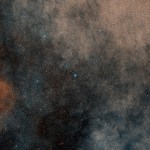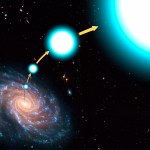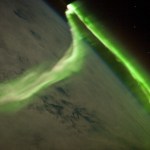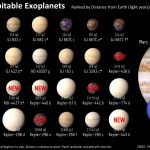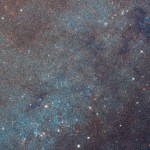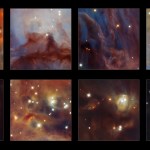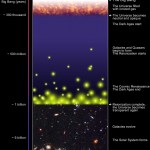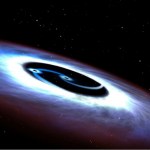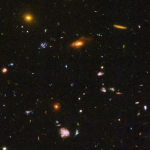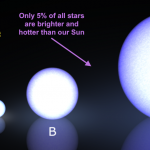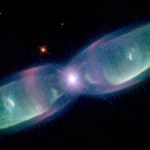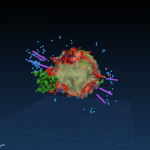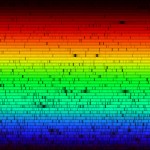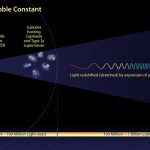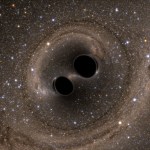Stars
“It matters not what someone is born, but what they grow to be.” -J.K. Rowling
From 19,000 light years away, Terzan 5 looks a lot like pretty much any globular cluster you'd expect to find: it's massive, concentrated, with a huge number of stars at right around 12 billion years of age. But mixed in there is a second population of stars just 4.5 billion years old, and tremendously represented in number as well.
This wide-field image, based on data from Digitized Sky Survey 2, shows the whole region around the stellar grouping Terzan 5. Image credit: ESO/Digitized Sky Survey 2.
We've never…
“Mapping out the elements in a star is like reading its DNA. We’re using those DNA readings to decode the history of the Milky Way from the stars that we can observe today.” -Steven Majewski
Most of the stars in our Milky Way have long lives ahead of them, with dozens or even hundreds of orbits around the entire galaxy to come over their lifetimes. With hundreds of billions of stars involved in this cosmic dance, it stands to reason that on occasion, another nearby star will either gravitationally or cataclysmically (e.g., from a supernova) kick such a star to incredible velocities, perhaps…
“Concentrate all your thoughts upon the work at hand. The sun’s rays do not burn until brought to a focus.” -Alexander Graham Bell
In 1859, the Sun surprisingly increased in brightness so significantly for just a brief while that it was noticeable from Earth during the day. Less than 24 hours later, aurorae were visible so brightly and so far south that people awoke in the middle of the night, thinking it was dawn. But in addition to the spectacular sights, there were also downsides: telegraph wires spontaneously caught on fire, causing significant amounts of damage.
The atmospheric effects…
"Our existence in this place, this microscopic corner of the cosmos, is fleeting. With utter disregard for our wants and needs, nature plays out its grand acts on scales of space and time that are truly hard to grasp. Perhaps all we can look to for real solace is our endless capacity to ask questions and seek answers about the place we find ourselves in." -Caleb Scharf
Now that we’ve learned the nearest star to our Sun, Proxima Centauri, has a rocky planet at the right distance for liquid water, it’s time to consider how we might learn the answers to our burning questions about it and all…
"To consider the Earth as the only populated world in infinite space is as absurd as to assert that in an entire field sown with millet, only one grain will grow." -Metrodorus of Chios
Later tonight, the European Southern Observatory is expected to make an announcement, and the smart money is on the discovery of an Earth-like planet orbiting Proxima Centauri, the nearest star to our Sun. As incredibly exciting as this news is, however, it’s important to keep in mind that “Earth-like,” to an astronomer, means something very different than what we think of as “actually like Earth.”
The…
"For something to collapse, not all systems have to shut down. In most cases, just one system is enough." -Robert Kiyosaki
Do supermassive black holes form from the merger and growth of many smaller black holes, falling towards a cluster/galactic center where they find one another and grow into a behemoth? Or is there a direct-collapse mechanism at play, where a black hole thousands, tens of thousands or even hundreds of thousands of times the mass of our Sun forms spontaneously?
The X-ray and optical images of a small galaxy containing a black hole many tens of thousands of times the mass…
“He who would search for pearls must dive below.” -John Dryden
If you want to know what types of stars are found all throughout a galaxy, looking at our own simply won't do: too much of it is obscured by the plane and our position within it. But there's an even more impressive galaxy -- Andromeda -- just 2.5 million light years away. And thanks to the power of the Hubble Space Telescope, we've not only resolved individual stars within it, we've resolved over a hundred million of them.
Closeup of a large region of the Andromeda galaxy's disk, containing hundreds of open star clusters (…
"...innumerable stars, thousands of double and multiple systems, clusters in one blaze with their tens of thousands of stars, and the nebulae amazing us by the strangeness of their forms and the incomprehensibility of their nature, till at last, from the limit of our senses, even these thin and airy phantoms vanish in the distance." -Mary Fairfax Greig Somerville
When you look at an active, massive star-forming region like the Orion Nebula, you expect to find new stars dominating, blowing off the gas and eventually bringing the episode of star formation to an end. Previous visible light…
“Dwell on the beauty of life. Watch the stars, and see yourself running with them.” -Marcus Aurelius
Let there be light! You’d think that would be enough: that you form stars in the Universe, you see those stars in the Universe, and that tells you about what’s out there. If only it were that simple.
The dark nebula Barnard 68, now known to be a molecular cloud called a Bok globule. Image credit: ESO, via http://www.eso.org/public/images/eso0102a/.
In order to truly see the first stars, you need a lot more that just starlight: you need that light to be able to freely travel through space.…
"Black holes can bang against space-time as mallets on a drum and have a very characteristic song." -Janna Levin
If you had told an astrophysicist five years ago that binary black holes were common, that would’ve been news, but not surprising. If you had told them that ~30 solar masses was a good estimate for each one of their masses, though, you might have had to pick their jaws up off the floor. Yet LIGO’s very first detection showed us exactly that, much to the surprise of many.
The inspiral and merger of the first pair of black holes ever directly observed. Image credit: B. P. Abbott et…
"Until the 1990s, there were few reliable observations about movement at the scale of the entire universe, which is the only scale dark energy effects. So dark energy could not be seen until we could measure things very, very far away." -Adam Riess
Just thirty years ago, scientists argued over the value of the Hubble expansion rate, and what it meant for the age, history and fate of the Universe. Was the Universe expanding slowly (~55 km/s/Mpc), was it very old, and would it coast to infinity? Or was it expanding rapidly (~100 km/s/Mpc), was it young, and would it eventually recollapse?…
"The bedrock nature of space and time and the unification of cosmos and quantum are surely among science's great 'open frontiers.' These are parts of the intellectual map where we're still groping for the truth - where, in the fashion of ancient cartographers, we must still inscribe 'here be dragons.'" -Martin Rees
Inside the nuclear furnace of the Sun, protons and other atomic nuclei are compressed together into a tiny region of space, where the incredible temperatures and energies try to overcome the repulsive forces of their electric charges. At a maximum temperature of 15 million K, and…
"We have known since the 1800s that carbon dioxide traps heat in the atmosphere. The right amount keeps the climate conducive to human life." -James Hansen
Thanks to our position in space, the energy output of the Sun, and the right atmospheric conditions on Earth, we have temperatures conducive to liquid water on our planet. Over the past 4.5 billion years, that's led to the flourishing and evolving of life, with our present existence marking something unlike anything else our planet's ever seen.
The very cold, polar regions of the Earth have a mean temperature far below the rest of the…
"The self-same atoms which, chaotically dispersed, made the nebula, now, jammed and temporarily caught in peculiar positions, form our brains; and the 'evolution' of brains, if understood, would be simply the account of how the atoms came to be so caught and jammed." -William James
When stars like our Sun run out of fuel, they expand into red giants, start fusing helium in their cores, blow off their outermost layers very slowly, and then their insides die. They heat up even further, contract down to white dwarfs, and the intense ultraviolet light ionizes and illuminates the blown-off…
“When a star goes supernova, the explosion emits enough light to overshadow an entire solar system, even a galaxy. Such explosions can set off the creation of new stars. In its own way, it was not unlike being born.” -Todd Nelsen
The vast majority of elements beyond hydrogen found on Earth were created inside a massive star and blown back into the interstellar medium in a catastrophic supernova explosion. In a certain way, everything you've ever held in your hand -- including another person's hand -- is you holding a dead star.
The Cassiopeia A supernova remnant, as imaged in the visible…
“There’s no god, it’s the elements that control this world and everything on it.” -Scott A. Butler
From hydrogen through uranium and even beyond, the Universe gives us a huge variety of elements that can bond together in practically innumerable ways, creating all the matter we've ever observed in existence. Everything beyond helium in the periodic table way made inside of stars, but not all stars create elements equally.
Artist’s impression of the red hypergiant VY Canis Majoris. Our Sun will become a more modest red giant, but a giant nonetheless. Image credit: Wikimedia Commons user…
“Exploration is in our nature. We began as wanderers, and we are wanderers still. We have lingered long enough on the shores of the cosmic ocean. We are ready at last to set sail for the stars.” -Carl Sagan
Glittering above high overhead, the canopy of night offers thousands of points of light, each one a blazing Sun, starring in the story of its own Solar System. But even armed with that knowledge, it's difficult to calculate exactly how far away such a star would actually be. The brightness/distance relationship is a great start, but stars intrinsically come in different brightnesses,…
"It is possible to commit no mistakes and still lose. That is not a weakness, that is life." -Jean-Luc Picard
The cosmic story common to all of us -- where we came from, how we got here and where we're headed into the future -- is both amazing and daunting. But when we're first exposed to the vastness of it all in terms of both time and space, it can be downright terrifying.
Image credit: NASA and the Hubble Heritage Team (STScI / AURA), Hubble Space Telescope / ACS.
This is particularly true for young children, who often experience a huge existential crisis when they realize that not only…
"When I was in high school, I was certain that being an astronaut was my goal. It was a very important time -- Sally Ride was making her first flight into space and she had a real impact on me. Those 'firsts' kind of stick in your head and really become inspirations for you." Karen Nyberg, astronaut
On September 14th, less than 72 hours after being activated at its highest sensitivity ever, the Laser Interferometer Gravitational wave Observatory (LIGO) detected its first unambiguous signal in both detectors, a signal that corresponded to the merger of two massive black holes: 36 and 29…
"The night has a thousand eyes, and the day but one;
Yet the light of the bright world dies with the dying sun." -Francis William Bourdillon
When we look for the brightest, bluest, most massive individual stars, we're restricted to looking nearby, since it's impossible to resolve individual stars at distances that extend much beyond our own galaxy. So how surprising is it, then, when the most massive stars we've ever found aren't in our own galaxy, nor in any of the monster galaxies we've found nearby, but in a small, satellite dwarf of our own: the Large Magellanic Cloud?
A combination…
